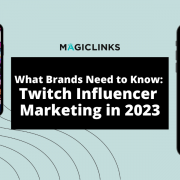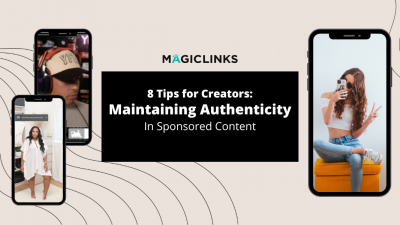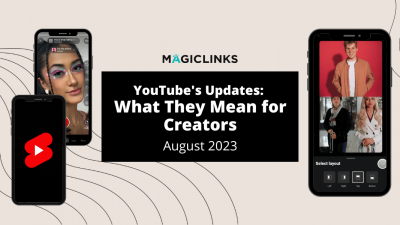Let’s talk about the not-so-glamorous, but oh-so-vital aspect of being a content creator: compliance. It’s not the most exciting topic in the world, but compliance is key to keeping your brand collaborations legit and your audience trusting in you.
In this blog post, we’ll break down the FTC guidelines for influencers in plain English, covering the basics of staying compliant on your social channels and how to thoughtfully disclose those sponsorships. By being mindful of these regulations, you’ll build a solid relationship with your followers and with brands. Let’s dive in!
FTC Guidelines for Social Media Creators
1. Include Clear & Comprehensive Disclosures
The FTC dictates that sponsorship disclosures must be made verbally, superimposed in the content, and included in the description. The definition of “clear and comprehensive disclosures” was updated in July 2023 to emphasize this point. To comply, all disclosures in sponsored content must be “difficult to miss and easily understandable by ordinary consumers.”
This means the disclosure should stand out in audio or text, and should not be suppressed or compete with surrounding audio or visual effects. Avoid mixing the disclosure with a group of hashtags or links, as this may cause confusion or lead to non-compliance.
2. Be Transparent About Endorsements
The FTC guidelines for influencers define an endorsement as any advertising message that consumers are likely to believe reflects the opinions, beliefs, findings, or experience of a party other than the sponsoring advertiser. Recently, the FTC revised the definition (due to the rise of creators!) to specifically include tags and Likes, along with product reviews and testimonials. Even if you don’t think a gifted product affects your evaluation, what matters is whether the fact that you got the product for free might affect how your audience views what you say about it.
Here’s how you can maintain transparency across channels:
Snapchat and Instagram Stories Endorsements
For endorsements posted in pictures on platforms like Snapchat and Instagram Stories, influencers must superimpose the disclosure over the picture itself. Additionally, creators need to ensure viewers have sufficient time to notice and read the disclosure.
Video Endorsements
For video channels, creators need to explicitly mention the endorsement in the video itself, not solely in the description. Viewers are more likely to notice and comprehend disclosures made in both audio and video formats. Be mindful that some viewers may watch without sound or may not see superimposed text, so conveying the disclosure verbally is vital.
Live Stream Endorsements
When making an endorsement during a live stream, the disclosure must be reiterated periodically throughout the stream. This repetition ensures that viewers who only catch a part of the stream will still receive the necessary disclosure. Maintaining transparency during live broadcasts is essential for ethical influencer marketing practices.
3. Know When a Disclosure is Necessary
Disclosures should be simple, straightforward, and easy for viewers to grasp. Phrases like “Thanks to Acme brand for the free product” can be sufficient, as long as they are not hard to miss. Remember, the goal is transparency, so audiences shouldn’t have to dig very deep for sponsorship information.
If you’re ever questioning whether a disclosure should be added to your content, remember this rule of thumb: if viewers would evaluate your content differently, knowing that the statements were motivated in part by a gift or incentive, there should be a disclosure.
For example, a disclosure would apply to the following scenarios:
- An advertiser gifts you a product with no expectation of an endorsement.
- You purchase a product using a discount code provided by the advertiser.
- You receive a product or discount code in exchange for entering a sweepstakes contest or writing a positive review.
- You’re in an always-on partnership with a brand. Even though your loyal followers might already know that you work with a brand, new posts must always include a disclosure because new viewers may not have seen the previous posts. You should also disclose your relationship even if you buy the brand’s product yourself.
- You post an additional endorsement on Instagram, even though your agreement with the brand only applied to Facebook. Even if you weren’t specifically paid to make the Instagram endorsement, you still have a paid relationship with the brand, and that could affect the weight or credibility given to that endorsement.
- You’re a YouTuber from the UK who posts a video about a product available in both the US and the UK, and your videos will be seen by and impact US consumers, not just UK customers.
- An advertiser gives you early access to review a product.
4. Utilize Platform Endorsement Tools
Many social media platforms offer built-in tools for influencers to disclose their partnerships with brands. As a best practice, influencers should use these platform tools – but not rely on them solely for disclosing sponsorships. Remember, make your endorsements and disclosures as “clear and comprehensive” as possible to ensure transparency and credibility.
5. Speak Honestly and Based on Personal Experience
Influencers should always speak honestly about the products they endorse and share their genuine opinions based on their personal experiences. After all, this is why audiences turn to creators – for trusted insights from real people. False or misleading claims aren’t just unethical and against FTC regulations; creators also risk losing the trust they’ve built with their followers. Influencers can’t make up claims about a product that would require proof the advertiser doesn’t have – such as scientific proof that a product can treat a health condition.
Examples of Perfect FTC Guideline Execution from MagicLinks Creators
Still not sure where and how to work these rules and regulations into your sponsored content? Check out the MagicLinks creator examples from Naomi Boyer and More Keta on YouTube. Their videos below showcase how transparency and authenticity can shine through while maintaining compliance with guidelines.
By following the FTC guidelines for influencers, the creator community and the brands that work with creators can foster an environment of integrity, credibility, and responsible advertising in the ever-evolving world of social media marketing.
To learn more, check out the official guidelines for social media influencers from the FTC.
And if you have questions about the compliance of your MagicLinks campaigns, reach out to us! We’re here to help creators and brands navigate these changes. Not part of MagicLinks creator network yet? It’s easy to apply here!










